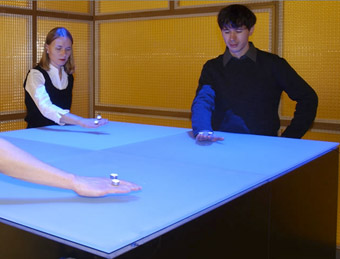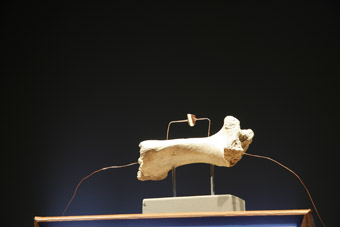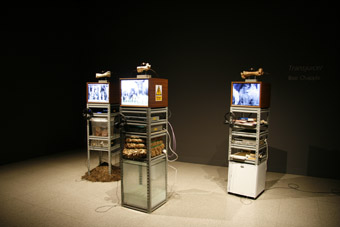envisaging the unseeable
urszula dawkins: art in the age of nanotechnology

Christa Sommerer and Laurent Mignonneau, 2002, Nano-Scape: user 06, supported by Volkswagenstiftung, Hannover
image courtesy of the artists
Christa Sommerer and Laurent Mignonneau, 2002, Nano-Scape: user 06, supported by Volkswagenstiftung, Hannover
IT’S ACTUALLY PHYSICALLY IMPOSSIBLE TO ‘SEE’ NANO-PARTICLES, AS ALL IMAGING AT THIS SCALE (1NM = 1 BILLIONTH OF A METRE) CAN ONLY CONSIST OF INTERPRETED DATA. SO AS CURATOR CHRIS MALCOLM PUTS IT, THE FIELD PROVIDES “FERTILE GROUND FOR ARTISTS WISHING TO CREATE NEW PATHWAYS TO THE PREVIOUSLY INVISIBLE LAYERS OF OUR MATERIAL EXISTENCE.”
But nano-imaging aside, all five works—both new and remounted art-science collaborations from Australia, the UK and Austria featuring in Art in the Age of Nanotechnology—display an engagement with ideas above and beyond the technology, with the possible exception of Christa Sommerer and Laurent Mignonneau’s work, Nano-Scape (2002).
Nano-Scape was developed for the exhibition Science+Fiction at Hannover’s Sprengelmuseum, and consists of a glowing blue table beneath which an array of electromagnets creates constantly shifting forces, stimulated by the movement of the user’s hand—wearing a kind of ‘ring’—over the surface. The camera-tracked movements of the ring are fed to an atomic-force simulator which ‘imagines’ the ring movements as those of one relatively stable atom among a hundred or so others. The user feels the resulting forces, simulated by the electromagnets.
In ‘real life’, such movement would cause all the atoms in the array to interact in a constant readjustment of their proximity to one another. This is the force that Sommerer and Mignonneau aim to demonstrate. In its initial form a screen out of view of the participants showed atomic patterns formed by the simulation. The screen has been removed in this remount, however, to strengthen the purely haptic experience of the impossible-to-equalise system; but without either a detailed explanation of what is simulated or the visible pattern of moving atoms, the work seems to lack artistic purpose, feeling more like a science display.
Both Paul Thomas and Kevin Raxworthy’s elegant Nano_essence (2009) and Mike Phillips’ shimmering A Mote it is…(2009) abound with references to philosophy and metaphysics, at the same time remaining firmly embedded in nanotech exploration. For Nano_essence, a single, cloned (hence potentially ‘eternal’) skin cell was analysed, to compare life and death at the nano level. In a cavernous, darkened space, the viewer breathes onto a plinth-mounted, perspex re-creation of the dying skin cell. In response, on a large wall-mounted screen, a multilayered representation of the cell begins to move in 3-D animation.
We fly beneath and through the layers of the cell, which appear like angular, transparent mountainscapes or a softly haunting 3D game as the square base of the ‘cell’ tilts and turns. Amid low rumblings and tappings, mysterious figures appear, or are they twists of DNA? It’s hard to determine, but the life-giving breath seems to people the subtle, layered landscape with something animate and self-determined. They move in their own shifting geometrical plane and disappear seemingly at will, extinguished somewhere between white ‘sky’ and soft, grey oblivion.
Mike Phillips’ A Mote it is… also employs the raw data of nano-imaging to produce a lush visual metaphor, here abstracted into swirling patterns referencing the elusive nature of both the nano-world and the everyday ‘mote’—that floating speck of dust on the surface of the eye that is impossible to actually see, but that nevertheless persists in peripheral vision. After scanning a mote of dust from his own eye, Phillips devised a constantly moving whirlpool of data-generated ‘particles’ mediated by face-recognition software. When viewed front-on, the swirl is entrancing; a sunburst-coloured play of light accompanied by an electronic soundscape. When the head is turned to one side, something seems to go against the tide—impossibly ephemeral particles appear and disappear, resonating with the ‘creatures’ of Nano_essence, perhaps, but in this case as barely perceptible as the mote itself.

Boo Chapple, Transjuicer, 2009, detail, John Curtin Gallery, 2010
image courtesy of the artist
Boo Chapple, Transjuicer, 2009, detail, John Curtin Gallery, 2010
A series of transformations is at the heart of Boo Chapple’s multifaceted and playful Transjuicer (2010). After becoming aware of the piezoelectric qualities of bone—when subjected to any mechanical stress it generates an electrical charge at the nano scale—the artist set about creating bone audio speakers, using the femurs of cows. Initially fascinated by this constant response of living bone to its environment and its potential as a metaphor for the complex interactions of life and world, Chapple found that the difficult process of trying to make the audio speakers pointed to other complexities, not least of which are the ‘transducings’, or conversions, that come into play between micro technological interventions and the macro social context, between living and dead matter, and between science lab and gallery.

Boo Chapple, Transjuicer, 2009, installation view, John Curtin Gallery, 2010
image courtesy of the artist
Boo Chapple, Transjuicer, 2009, installation view, John Curtin Gallery, 2010
Transjuicer consists of three screens atop rack mounts that house bales of straw, a tank of rotting cow bones, shelves of lab reference books and three audio players with headphones. On the top of each tower sits a highly polished cow femur wired to the small sections of bone that constitute the ‘speakers.’ Tinkling through the headphones, Chapple’s three successful recordings are distant, distorted renditions of “Dry Bones”, “Old MacDonald” and “Good Vibrations”—recordings made, after many unsuccessful attempts, by a laser interferometer. The video screens play loops of cows at the milking shed. Chapple describes Transjuicer wryly as “milking it.” The work’s playfulness trots lightly over the process, but Transjuicer succeeds in illuminating some awkward, absurd and inescapable liaisons between art-making, primary production, the mastery of materials and messing around with living matter.
Victoria Vesna and James Gimzewski’s Nanomandala (2003), reviewed separately in this issue, is, put simply, an extended zoom from macro to nano scale and back out again, its focus the Tibetan Buddhist sand mandala of Chakrasamvara, created for the first time in the USA by monks from the Gaden Lhopa Khangtsen monastery. More subtly interactive than some of the other works here, Nanomandala, projected onto a two-metre disk of sand, has meditative qualities; the saturated colours of the mandala inviting immersion in a slowly changing, seamless progression to the limits of imaging. A spiritually focused artwork, Nanomandala also has an illustrative simplicity, displaying the conundrum that grounds all the works in Art in the Age of Nanotechnology: the ability to ‘see’ what is in a literal sense unseeable—particles of matter that are smaller than wavelengths of light.
Art in the Age of Nanotechnology, curator Chris Malcolm, artists Paul Thomas and Kevin Raxworthy (Australia), Mike Phillips (UK), Victoria Vesna (USA) and James Gimzewski (Scotland), Christa Sommerer (Austria) and Laurent Mignonneau (France), Boo Chapple (Aus); John Curtin Gallery in association with Curtin University Centre for Research into Art, Science and Humanity; Curtin University of Technology, Perth, Feb 5-April 30.
RealTime issue #96 April-May 2010 pg. 26






